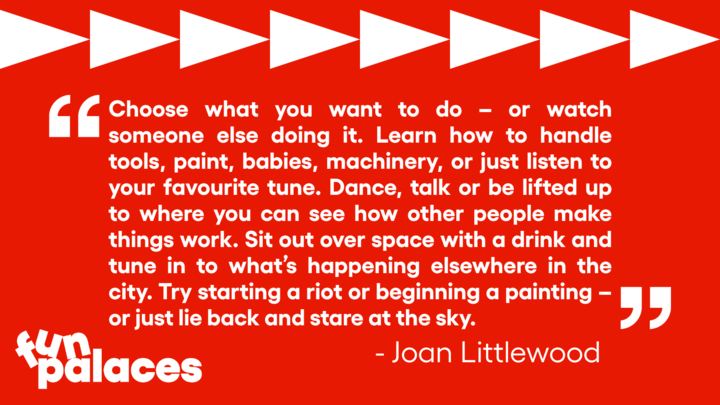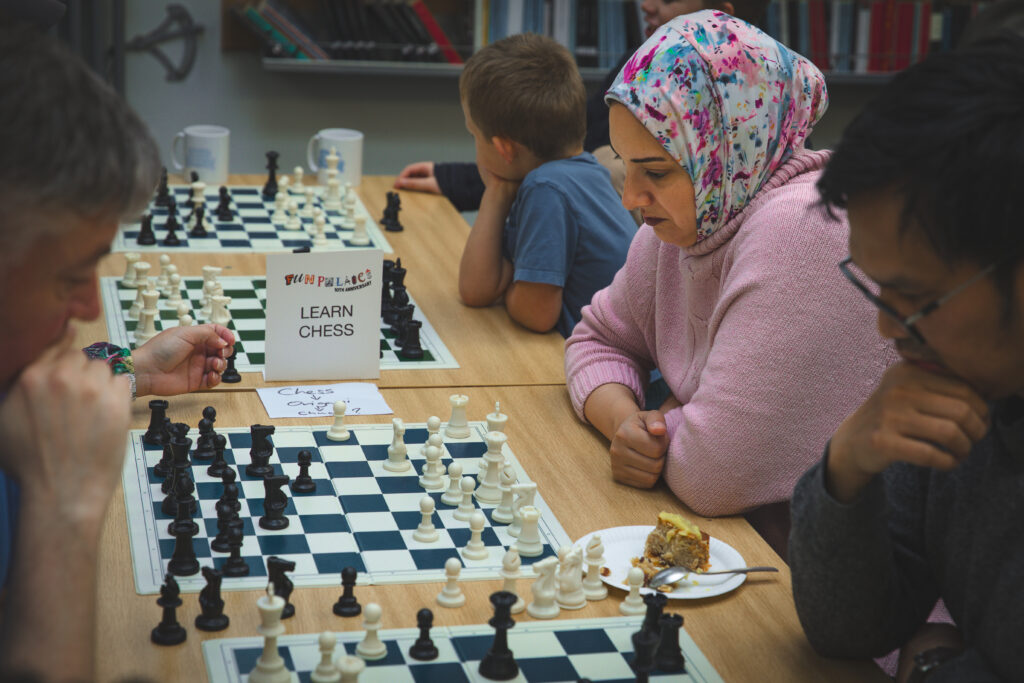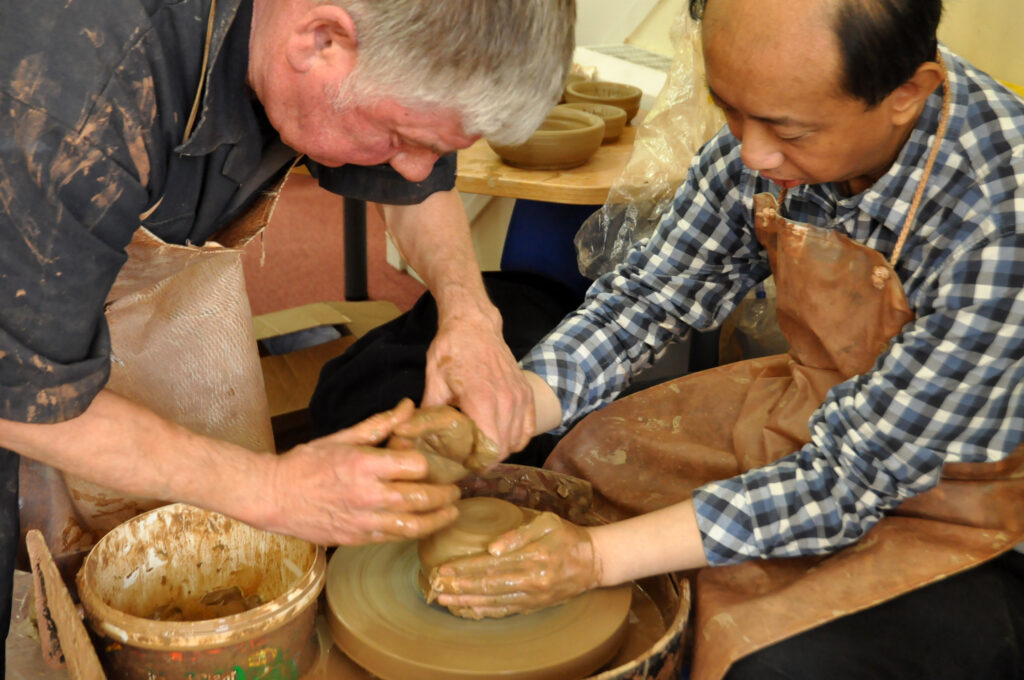Ria Patel joined Fun Palaces as the co-ordinator in January this year. They are passionate about diversity, meaningful inclusion and fostering belonging.
As Fun Palace Makers know, there is much more to Fun Palaces than just frivolous fun (although that is, of course, a hugely important part). Here, 6 months into working two days a week at our Fun Palaces Support Hub, Ria writes their first Fun Palaces blog, sharing some of their own thoughts and reflections around Fun Palaces, community care, radical fun, and why play is so important right now. And if you’re on the fence about making a Fun Palace this October, perhaps this will persuade you…
In a world increasingly driven by stress, isolation, and disconnection, play might seem frivolous, but what if play held the key to transforming our communities and reimagining how we care for one another? Joyful, creative, inclusive play, making arts and culture grassroots, challenging the status quo.
That’s the radical idea behind Fun Palaces, celebrating the power of culture, creativity, and community-led action. These are not your typical arts events, festivals or fairs. Fun Palaces are DIY spaces of joy, where you can learn from neighbours – or maybe everyone is invited to share a secret skill. You connect and can rediscover your capacity to shape the world around you.

Fun is not Frivolous
Fun Palaces began with a bold vision: that culture belongs to everyone, not just institutions, elites, or experts. Inspired by the dream of theatre director Joan Littlewood and architect Cedric Price in the 1960s, today’s Fun Palaces are often temporary spaces, sometimes just a corner of a library, a park, or a community centre, where people come together to create and experience culture.
But they can lead to longer term change. Because play is powerful. When people gather to dance, paint pebbles, brick-lay, create micro-plays, willow weave, explore coin collections, learn about local history, and more, something profound happens: barriers dissolve. Generations mix. Strangers become collaborators. People feel seen, valued, and connected. The simplicity of “fun” becomes a gateway to healing, empowerment, and belonging by helping people feel more connected, make friends, and get to know their local area better.
Community Care starts with Trust
Fun Palaces are about mutual care—the kind that grows when people are trusted to show up as themselves. There’s no hierarchy: a retired welder might teach soldering, a teenager might host a zine workshop, a dad might lead storytelling. This kind of exchange builds trust and connection in an organic way.
In a society where places for connection are increasingly professionalised and privatised, Fun Palaces remind us that community care begins with connection. By laughing, playing, and creating side by side, we build a sense of joy and community connection – one which will hopefully transcend beyond the Fun Palace into people’s lives.

Intersectionality, joy and justice
People are creative, and everyone deserves access to culture, community, and care. But to truly live up to that vision, we have to go deeper than feel-good inclusion. We have to ask: who still gets left out, even in the name of “community”?
That’s where intersectionality comes in, as a lens for building spaces that are genuinely equitable, joyful, and just.
Coined by Kimberlé Crenshaw, intersectionality describes how overlapping identities, e.g. race, gender, disability, class, sexuality, migration status, etc., interact to create unique experiences of discrimination or exclusion.
In the context of Fun Palaces, intersectionality helps us move beyond a one-size-fits-all approach to inclusion. It asks us to notice:
- Who feels safe and welcome in a space?
- Who gets to lead, and whose contributions are celebrated?
- Whose needs are met? Whose are unintentionally ignored?
Inclusion is about shifting power. The most meaningful change comes when we see and honor the full complexity of people’s lives. In a world that too often divides and dehumanises, and where people can struggle to experience joy, joy is a justice issue. And collective creativity can help us come together with our differences, build solidarity, empower, resist, and transform. By having inclusion as a foundation, Fun Palaces can help make creativity, learning, and joy accessible to all, regardless of age, income, ability, or background.
From Celebration to Revolution
Celebration can disrupt business as usual. When communities reclaim space and knowledge from top-down systems, they start to shift power. They ask different questions: Who gets to decide what culture is? Who has access to joy? What does a caring community really need?
Fun Palaces offer a living example of what real inclusivity can look like. And in doing so, they challenge the narratives of scarcity and division that keep communities apart. Adults can often see play as only for children, and in challenging times, play can feel like a luxury. But by creating #CreativeRiots, Tiny Revolutions, and making Fun Palaces, we can ignite sparks of fun and imagination that ripple through our communities. With small changes – by doing community spaces, arts and sciences differently, by disrupting the status quo, by valuing community knowledge not just expertise – we pave the way for revolution, where society’s power structures and governance fundamentally transforms. And by centering creativity as a collective, not commercial, act, Fun Palaces model what social change can look like at the grassroots: slow, joyful, messy, and real. So whether you’re painting a mural, sharing a recipe, or writing a neighbourhood storybook, know this: it’s not just fun – maybe it’s change in motion.
If you want to make a Fun Palace this 3rd-5th October (or another time if the dates don’t work for you) – we have lots of resources for getting started here. If you would like to chat through your idea with someone at the Fun Palaces Support Hub, drop us an email to arrange a call. And once you know your location, you can put your Fun Palace on the map.

